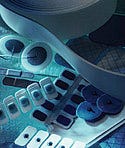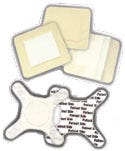Whether they are used for wound-care products or for adhering devices to the skin, medical adhesives are increasingly being tailored to the patient and the application
November 14, 2009
Originally Published MPMN November/December 2009
PRODUCT UPDATE
Adhesives: One Size Does Not Fit All
Whether they are used for wound-care products or for adhering devices to the skin, medical adhesives are increasingly being tailored to the patient and the application
|
Berry Plastics manufactures a range of medical adhesive products, including adhesives for electrodes. |
When people think of pressure-sensitive medical adhesives for wound-care and other skin applications, they often think of Band-Aids and the discomfort they cause when they are removed. But medical adhesives are not composed of just any old sticky stuff. That “sticky stuff” must have a range of properties, from stretchability, conformability, and comfort to breathability, moisture absorbency, porosity, and longevity. And if it is to be used for critical wound-care treatments, it may also need to incorporate antibacterial characteristics.
Depending on a range of factors—from the application to the age of the patient—adhesive products are formulated to serve specific needs. If the application is a wound-care device, for example, the moisture-vapor transfer rate (MVTR) is the most critical consideration. Other parameters requiring evaluation are the tape’s skin sensitivity, fluid resistance, shelf life, color characteristics, expected duration on the skin, adhesion, tack, and shear. In short, when it comes to today’s pressure-sensitive medical adhesives, one size does not fit all.
From the Bottom Up
It all starts with a substrate, remarks Mark McDonough, medical market manager of Scapa North America (Windsor, CT; www.scapana.com). “Pressure-sensitive adhesives are coated onto a variety of substrates that are used in wound-care applications, in device applications, or in ostomy applications,” he explains. Made from woven and nonwoven fabrics, substrates are supplied as thin-increment foams, polyethylene foams, PVC foams, polyurethane foams, or films. In contrast, the adhesive is usually an acrylic material based on rubber, polyurethane, or silicone.
|
Scapa offers many adhesive tapes, such as wound dressings (top) and catheter holds (bottom). |
Scapa provides an array of wound-care products with adhesives on one or both sides of the substrate, McDonough states. In the area of silicone gel adhesives, the company offers both Rx1267P and Rx1268S, one- and two-side-coated thermoplastic films, respectively. The single-sided tape product is coated with a silicone gel adhesive on the side that adheres to the skin, while the double-coated product has a silicone gel adhesive on the skin side and an acrylic laminating adhesive on the other to hold a device in place.
Flexibility, breathability, and other characteristics critical to wound-care products depend on the backing, McDonough says. “Very often it’s the substrate that embodies the unique property of the tape.” For example, the company’s 4005-800a is a soft polyurethane-foam-based one-side-coated adhesive tape product that offers levels of breathability, conformability to the skin, and handleability that are not provided by films and fabrics, according to McDonough.
“For dressings and all kinds of patches that are put on the skin, it is desirable for them to exhibit breathability—a high moisture-vapor transmission-rate quality—so that perspiration can evaporate through the material,” McDonough notes. The most commonly used materials for such applications are polyurethane films—thin films perhaps 0.001 in. thick that contain a 0.001-in.-thick acrylic adhesive layer. “Patches and wound dressings made from this material allow for longer-term wear, because if the skin can breathe, it will allow the patch to stay on longer.”
Featuring more “hand,” Scapa’s 4005-800a pressure-sensitive tape is thicker than standard polyurethane film, making it easier to apply to the skin. “Picture holding a very thin film in your hand: It’s going to drape over on itself and be hard for the healthcare professional to work with,” McDonough says. “Thus, we offer a thin-increment foam that has the same breathable quality as very thin polyurethane foam, yet it is much more handleable. Ease of application is the key here.”
Zeroing In on Specific Applications
Medical adhesives are frequently custom products. “As far as adhesion performance, the requirements vary,” McDonough states. “They run the gamut from fragile-skin applications, which provide very light adhesion and absolutely no trauma to the skin upon removal, such as tapes used on neonates and the elderly, to adhesives that are designed for long-term wear—for example, for medical devices or wound-care applications.” The industry goal for device adhesion is tapes that will hold and bond to the skin for up to seven days.
“You wouldn’t put the same adhesive on a newborn or elderly person that you would put on a middle-aged person,” comments George Kontakos, director of sales and marketing, specialty tapes, at Berry Plastics (Franklin, MA; www.covalenceadhesives.com). “Unfortunately, most products are designed for the general market.” In contrast, Berry Plastics manufactures a range
of custom acrylic and synthetic elastomer adhesives. Fabricated using emulsion, solution, or solventless technology, they are employed in conjunction with bandages, wound-care products, electrodes, pulse oximeters, diagnostic equipment, and transdermal patches.
The company specializes in unique adhesive formulations. “I think that the difference between us and some of our competitors is that we add resins or tackifiers to formulate unique adhesive systems,” Kontakos emphasizes. By adding resins or tackifiers to commercially available base adhesive systems, Berry Plastics modifies the properties of its adhesive products. “We can make tapes that are more sticky, less sticky, more resistant to moisture, or less aggressive for sensitive-skin applications,” Kontakos says. “That’s how we zero in on a specific application.”
Manufacturing a range of wound-care products, from wovens and nonwovens to flexible films and foams, the company also provides custom laminates in which it uses multiple components to form a sandwich-type composite product. “Let’s say that you have a woven or a nonwoven substrate where the customer needs a specific feel or comfort level, but it must be waterproof,” Kontakos says. “We might laminate the woven or nonwoven material to a film and then put an adhesive on the backside of it. In essence, the result is a custom-designed single-coated product with more than one layer.”
Custom Formulating Hydrocolloids
If customization is the name of the game for pressure-sensitive medical adhesives, hydrocolloidal formulations are no exception. Designed for wound-care and other medical applications, hydrocolloid adhesives feature a high MVTR and are hypoallergenic. The material is engineered to maintain moisture in the wound bed and absorb exudates, making it suitable for long-term wear of up to seven days. Most hydrocolloids combine with wound exudate to form a gel-like covering, which protects the wound bed and maintains a moist wound environment. In addition, hydrocolloid conforms to the skin and is comfortable.
“Hydrocolloid was originally designed for the ostomy industry,” remarks Jeff Ruch, president of Amparo Medical Technologies Inc. (Placentia, CA; www.amparomedical.com). “When you attach an ostomy bag, it must be removed without trauma to the skin.” But after the material was developed, researchers discovered that it helped to heal the periwound—the area around the stoma—leading to its use in wound-care applications. “Wound-care hydrocolloid became more absorbent, resulting in the highly absorbent and skin-friendly material used today.”
Composed of an absorbent component, a filler material that’s typically a rubber component for providing body, and an adhesive, hydrocolloid is not a coated product. “Very few companies make it because it’s manufactured like rubber,” Ruch says. “At Amparo, we’re set up for custom formulations. We have a small pilot mixer in which we can make as little as 5 lb of hydrocolloid for pilot runs. We custom formulate, and we can adjust the adhesion level, the absorption, the density, the modulus—all kinds of properties—depending on what we’re trying to accomplish.”
Because of its high-tack, easy-peel properties, hydrocolloid adhesives can outperform acrylic-based adhesives for such applications as catheter securement, according to Ruch. “Hydrocolloid can remain on the skin for two, three, four days,” Ruch notes, “but when you want to remove it, you’re going into peel mode, so it actually comes off easily.” The material even sticks to sweaty or oily skin, Ruch adds. “After three or four days, the patient’s sweat or other body fluids are absorbed by the hydrocolloid, and after about three days, adhesion begins to break down, aiding in the adhesive’s removal.”
As a custom formulator, Amparo fine-tunes
its adhesive products to meet specific needs. “There’s always going to be a place for a cheap down-and-dirty adhesive that sticks well for a while,” Ruch concludes. “But there’s an important place for specialty products that must stick better, remain on the skin for seven days, and remove easily without causing trauma. That’s why the future will see a lot more customization for specific applications.”
For more articles on adhesives and adhesive products, go to www.devicelink.com/mpmn/adhesives
Copyright ©2009 Medical Product Manufacturing News
You May Also Like




